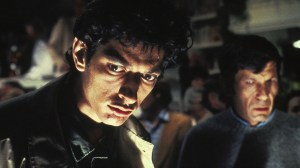With the end of the “Black Dawn” storyline this week in Superman #25, the creative team of Peter J. Tomasi, Patrick Gleason, and Doug Mahnke pitted Superman against Manchester Black, one of the most formidable villains created for him in the last 20 years — and the end result was nothing short of shocking.
Videos by ComicBook.com
After “shorting out” Manchester Black’s mental powers with psychic feedback, Superman took the villain’s body — seemingly braindead — away, presumably to a hospital or STAR Labs/ARGUS/The Fortress of Solitude.
After the fight, the story got some wrap-up with Superman, Lois, and his son Jon — but then it cut back to Hamilton County, the farming community where the Kent family had been living in relative quiet during their time away from Metropolis since Jon was born.
A cow (presumably one from the neighbor’s dairy farm, which served as a staging ground for Manchester Black’s attack on Superman’s family) approaches a group of kids and reveals himself to either be Manchester Black, or at least be a current vessel that Black is using to house his powers while his body is out of reach.
The seemingly-obvious next move would be to pit the Manchester Black cow against Bat-Cow, Damien Wayne’s pet from Batman and Robin, in a “Batcow v. Supercow: Dawn of Buttermilk” kind of way.
Ruining Superman’s life has been a bit of a recurring motif for Black, who first appeared in Action Comics #775, widely regarded as one of the best Superman stories in recent decades. The tale, written by Joe Kelly and featuring art by Mahnke, centered on Black and his Team The Elite, who were proxies for popular, ultra-violent English superhero characters popular at the time in books like The Authority. They believed that superheroes who refused to kill villains were ignoring a moral imperative to make the world safer and, in turn, were just as bad as those they fought — and they wanted Superman to get violent, or get out of the way. When Superman appealed to their decency, it didn’t work — so ultimately he used his powers and guile to defeat them, but spared their lives.
The story, titled “What’s So Funny About Truth, Justice, and the American Way?,” is one of a handful of stories we recently noticed were apparently rendered canonical when Superman’s timeline was laid out in Action Comics last month. It was later adapted into an animated feature film, titled Superman vs. The Elite. While it was the kind of story that seemed destined to be a single-issue, strand-alone parable, the popularity of the story (and, inevitably, of Black and his contemptible teammates) led to numerous follow-ups, with Black briefly leading the Suicide Squad and an Elite-driven story in JLA. The team was featured in a spinoff, Justice League Elite, written by “What’s So Funny…?” author Joe Kelly.
A New 52 take on Black saw him as a mysterious and scheming S.T.A.R. Labs employee, although given the restoration of much of Superman’s history post-Rebirth, it seems likely that take on the character will be as forgotten as the Hank Henshaw briefly mentioned in the post-Flashpoint world but later replaced with one thate more closely resembled his pre-Flashpoint counterpart.








